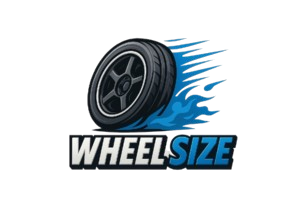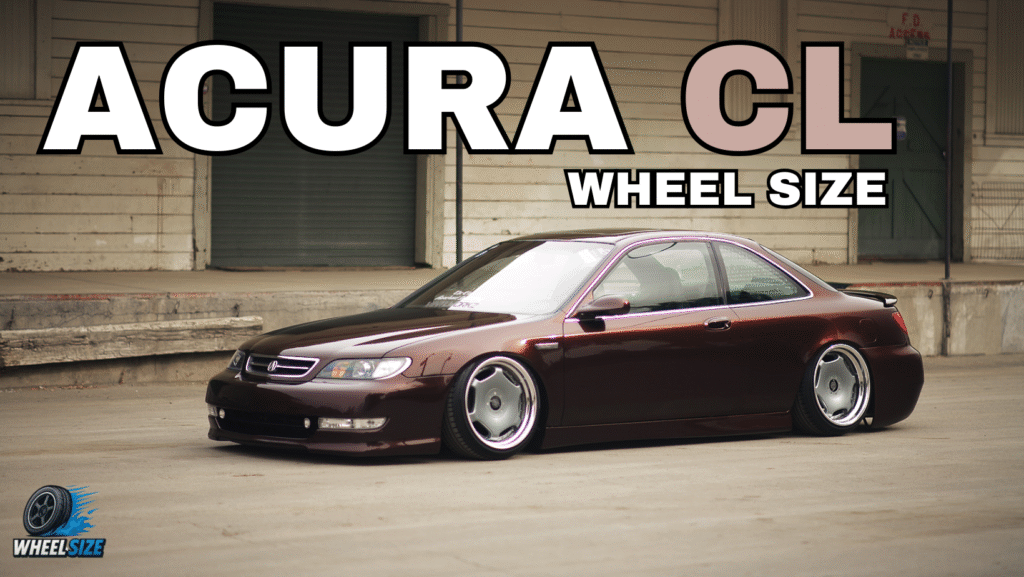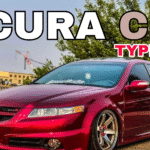Introduction
If you have an Acura CL or are thinking about getting new wheels for it, it’s important to know what size wheels will fit. The Acura CL was made from 1997 to 2003 and had two main generations: the first generation (1997–1999) and the second generation (2001–2003). The wheel bolt pattern, rim size, hub bore, and offset requirements are different for each generation. These things affect how your wheels sit and work.
Not only does bad wheel fitment change the way your car looks, but it also makes it less safe, harder to drive, and wears out your tires faster. This page shows you the specs for both versions, including factory sizes and the range of aftermarket upgrades that are available. This advice will help you avoid rubbing, clearance problems, or mismatched tire sizes, whether you’re replacing factory rims or getting aftermarket wheels for a flush stance.
Let’s talk about all the important things you need to know about the Acura CL wheel dimensions, from the bolt pattern to the offset and everything else.
Read About: Acura CDX Wheel Fitment
Acura CL Wheel Fitment Overview
Wheel fitting is how well the wheels and tires fit in the wheel wells of your car. The most significant parameters to look at are the tire size, bolt pattern, center bore (also called hub bore), rim width and diameter, and offset. Each of these things has an effect on how your wheels work and whether they can go over suspension parts, fenders, and brake calipers.
The first-generation Acura CL (1997–2000) used a 4×114.3 bolt pattern and a 64.1 mm center bore. The second-generation (2001–2003) changed to a 5×114.3 bolt pattern with the same diameter. Depending on the year and trim, the rim diameters ranged from 16″ to 18″, and the offset values ranged from 48 mm to 57 mm.
1st Generation Acura CL Wheel Fitment (1997–2000)
The 4-lug bolt pattern on the first-generation Acura CL (YA1 chassis) was 4×114.3 mm, while the hub bore was 64.1 mm. The wheels were 16 inches in diameter at first, but subsequent models had wheels up to 18 inches in diameter. Offset values usually fell between 48 and 52 mm, which helped keep the wheels in the right place along the fender line.
The CL had 205/55R16 tires on 6Jx16 ET50 rims in 1997. The OEM tire size expanded to 205/45R18 on 7Jx18 wheels with a 50 mm offset by 1999. This made the car look more sporty and changed how it handled and how comfortable it was to ride in. When buying aftermarket parts, it’s crucial to have the offset and width right so that they don’t rub against the suspension or fenders.
If you’re replacing your standard wheels or getting bigger ones, make sure they stay between 16″ and 18″ to keep the ride quality and clearance right. The threads on the lug nuts stay the same over the years at M12 x 1.5.
Acura CL YA1 [1997–2000]
| Year | Center Bore | Bolt Pattern | Lug Nut Thread | OEM Tire Size | OEM Rim Size | OEM Offset Range (mm) | Tire Pressure (F/R) | Aftermarket Wheel Range |
| 1997 | 64.1 mm | 4×114.3 | M12 x 1.5 | 205/55R16 | 6Jx16 ET50 | 48–52 | 2.3 / 2.3 | 16″–18″ |
| 1998 | 64.1 mm | 4×114.3 | M12 x 1.5 | 205/50R17 | 6.5Jx17 ET50 | 48–52 | 2.3 / 2.3 | 16″–18″ |
| 1999 | 64.1 mm | 4×114.3 | M12 x 1.5 | 205/45R18 | 7Jx18 ET50 | 48–52 | 2.5 / 2.5 | 16″–18″ |
| 2000 | 64.1 mm | 4×114.3 | M12 x 1.5 | 205/45R18 | 7Jx18 ET50 | 48–52 | 2.5 / 2.5 | 16″–18″ |
Hub Bore Size
The hub bore size for all generations of Acura CLs is 64.1 mm. This number tells you how big the hole in the middle of the wheel is that fits over the hub of your car. A perfect fit is vital because the hub bore makes sure the wheel is centered, which cuts down on vibrations and keeps your driving smooth.
If you’re putting on aftermarket wheels with a bigger hub bore, you can utilize hub-centric rings to fill the space between the wheel and the hub. This makes sure that the wheel stays balanced and is firmly attached. But if you use wheels with a smaller hub bore than the vehicle’s hub, it could be hard to mount them or make driving risky.
If you’re getting new wheels, always confirm that they fit the 64.1 mm hub bore to avoid complications later on.
Offset Range
Offset is the space between the wheel’s centerline and the mounting face that connects to the hub. The factory offset range for the Acura CL changes from year to year and generation to generation, although it usually falls between 48 mm and 57 mm. Offsets for the first-generation CL are normally between 48 mm and 52 mm. For the second-generation versions, they can be as high as 57 mm.
It’s very important to choose the right offset since it changes how much the wheel sticks out or sits in. If you’ve lowered your car or are using bigger tires, an incorrect offset can cause the fenders or suspension parts to grind against each other.
When you buy aftermarket wheels, it’s best to stick to the factory offset standards to make sure they fit and handle well. If you want a more aggressive stance, just make sure to test fit and think about changes like rolling fenders or adding spacers.
2nd Generation Acura CL Wheel Fitment (2001–2003)
The second-generation Acura CL (YA4) made several big changes to the requirements for the wheels. It kept the 64.1 mm center bore but changed to a 5-lug design (5×114.3 mm). Because of its common bolt pattern, this generation makes it easier to upgrade wheels after they are bought.
The standard model in 2001 hhad205/60R16 tires on 6.5Jx16 ET55 wheels. The Type-S had bigger 225/50R17 tires on 7.5Jx17 ET50 rims by 2003. These tires gave it improved grip and a sportier look. The offset values for these models were usually between 50 mm and 57 mm, which kept the fit balanced for both comfort and performance.
This generation’s recommended aftermarket wheel size range is 16 to 17 inches. You can get bigger, but you may need to tune the suspension or change the fenders to keep them from rubbing. For safe mounting, always use M12 x 1.5 lug nuts.
Acura CL YA4 [2001–2003]
| Year | Center Bore | Bolt Pattern | Lug Nut Thread | OEM Tire Size | OEM Rim Size | OEM Offset Range (mm) | Tire Pressure (F/R) | Aftermarket Wheel Range |
| 2001 | 64.1 mm | 5×114.3 | M12 x 1.5 | 205/60R16 | 6.5Jx16 ET55 | 53–57 | 2.2 / 2.2 | 16″–17″ |
| 2002 | 64.1 mm | 5×114.3 | M12 x 1.5 | 205/55R17 | 7Jx17 ET50 | 53–57 | 2.3 / 2.3 | 16″–17″ |
| 2003 | 64.1 mm | 5×114.3 | M12 x 1.5 | 225/50R17 | 7.5Jx17 ET50 | 53–57 | 2.3 / 2.3 | 16″–17″ |
Aftermarket Wheel Fitment for Acura CL
If you want to keep your Acura CL drivable, you should only get aftermarket wheels that are the right size. The best wheels for the first-generation CL are 16 to 18 inches in diameter and have offsets between 48 and 52 mm. For the second generation cars, the optimal wheel size for looks and performance is 16 to 17 inches with offsets between 50 and 57 mm.
If you want a more aggressive stance, you can choose bigger wheels and lower-profile tires. Just be aware that this could cause problems with fender clearance and suspension travel. Lowering your automobile might make these problems worse, especially if you go past the factory width or offset.
Always check to see if your wheels fit before putting on tires, and think about utilizing hub-centric rings for aftermarket wheels with a bigger bore. This maintains your ride smooth and stops vibrations.
Acura CL Lug Nut Sizes & Torque Specs
All years of the Acura CL use lug nuts with an M12 x 1.5 thread size. These are common in many Honda and Acura cars and are easy to change or improve. Always use the right type of seating for your lug nuts when you put on factory or aftermarket wheels. For aftermarket wheels, this is normally a conical seat.
It’s best to torque your lug nuts between 108 and 120 Nm to make sure they stay snug without being too tight, even though official torque specs may be somewhat different. After driving a few kilometers, especially after replacing wheels or rotating tires, make sure to check the torque again.
Using a good torque wrench makes sure that your wheels are installed evenly and safely, which stops the brake rotor from warping and the studs from getting unequal pressure.
Suspension Modifications & Wheel Fitment
Putting springs or coilovers on your Acura CL to lower it can make it look more aggressive, but it also changes how the wheels fit. When the suspension compresses, there isn’t as much room for larger wheels or lower offsets. That’s why it’s important to know how far your automobile can go and how high it can go when you buy aftermarket wheels.
If you choose a wheel setup that goes beyond what the factory recommends, you might want to roll your fenders or use mild negative camber to keep them from rubbing. You should also change the size of the tires to fit the increased ride height. Tires with lower profiles can help, but they can also make the ride harder.
In the end, a lower CL can manage wider wheels, but you need to prepare ahead. Always try it on, measure it, and ask specialists for help if you need it.
Conclusion
Upgrading the wheels on your Acura CL can change how it looks and how it drives, but it’s important to get the fit right. Every specification, from the bolt pattern to the offset, affects safety and performance. This guide has all you need to know to make an informed choice, whether you want a flush fitment or a factory replacement.
Keep in mind that you should stay within the acceptable limits, use the right hardware, and never sacrifice fit for looks. A balanced setup gives you better handling, longer tire life, and a smoother ride.
FAQs
Q: Can I fit 19-inch wheels on my Acura CL?
A: While it’s possible, it may require fender rolling or suspension adjustments to prevent rubbing.
Q: What’s the difference between 4×114.3 and 5×114.3?
A: The first is a 4-lug bolt pattern used on older models, while the second is a 5-lug pattern used on newer ones.
Q: Do I need hub-centric rings for aftermarket wheels?
A: If the new wheels have a larger center bore than 64.1 mm, yes—they help eliminate vibrations.
Q: Can I use spacers on the Acura CL?
A: Yes, but only if used safely and with extended studs. They can help correct offset issues.
Q: What’s the ideal offset for a flush look?
A: For most setups, +45 to +50 mm gets you close to flush without causing clearance issues



